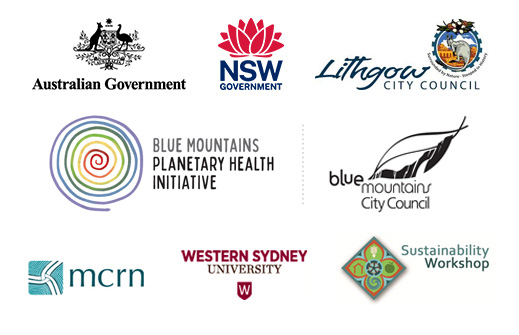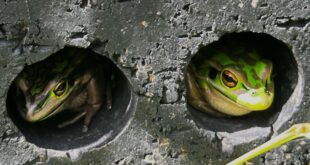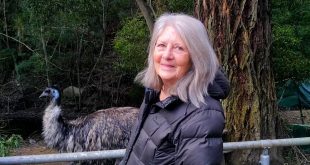
Hartley Rural Fire Service Volunteers Jacqui Evans, Ethan Forester and Kaitlyn McLaughlin at Get Ready Weekend
Story and photos by Tracie McMahon
In NSW the Rural Fires Act declared the period 1 October 2023 to 31 March 2024 as Bushfire Danger Period. It is a time when fires can quickly escalate, causing catastrophic damage to property and lives. In September each year, rural fire sheds across NSW, including Hartley, host Get Ready days to help their communities prepare. Hosted by local brigade members, they provide invaluable advice on local conditions and things you can do to prepare your property and family for fire season.
Key Points:
- A well-prepared property and bushfire survival plan are essential in bushfire prone areas.
- Access to water and properties are essential for reducing damage. If you have a accessible dam, pool or tank on your property, put a static water supply (SWS) sign at your property entrance, so the RFS knows water is available.
- If you have questions, want to volunteer, or would like to get to know the Hartley volunteers, they meet every Thursday 6-8 pm at the Hartley Rural Fire Service Shed, Mid Hartley Road, Hartley.
I’m quite surprised when I arrive at Hartley Shed for Get Ready Day. So much has changed since I was a member of this brigade over twenty years ago. ‘Back in the day’ we met monthly to train and organise back-burning, supported by one or two trucks, and I reckon I made a sausage sandwich or two. I was expecting to happily indulge in a BBQ lunch, check out the trucks and equipment and be on my way. Instead, I am greeted by complex firefighting equipment, professionally prepared handouts and uniformed men, women and youths, ready to respond to the questions of their community.
Three tables are loaded with resources covering everything from bushfire survival plans for people, properties, and animals, to facts about lighting a fire at any time of the year. A dozen volunteers are available to answer questions. As I fill my bag with pamphlets, locals come for advice: asking questions about firefighting pumps, making decisions about when to leave, or initiating young children into the sights and sounds of fire season in Australia.
Christina Forester, Hartley Rural Fire Brigade Community Engagement Officer, explains that it is important that everyone assess their own risks, as every property and person is unique. The information available in the handouts has been prepared by experts to guide households through the steps involved in preparing for fire. All the resources on hand at Get Ready Weekend are also available online here: https://www.rfs.nsw.gov.au/plan-and-prepare
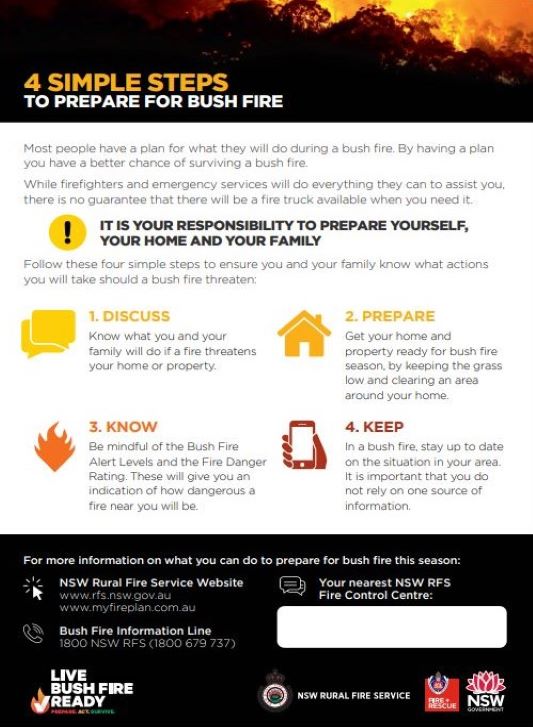
Key steps recommended by the NSW Rural Fire Service to prepare for a bush fire.
Outside the shed there are three state-of-the-art fire vehicles, including a specialised unit designed for structural fires. Lewis and Logan Gurney, who at fifteen-years-of-age have been cadet members of the RFS for three years, point out some of the equipment they are learning to use. They will be able to work on a fireground at sixteen once they have completed the relevant training modules.

RFS cadets: Lewis and Logan Gurney explaining equipment used in structural firefighting
I ask the cadets how they feel about active firefighting and they tell me they are looking forward to completing their BF qualifications and assisting on the fire front. Their father, Corey Gurney, explains that even as cadets their efforts are highly valued. The brigade has over seventy members aged from twelve to almost ninety. Age and physical ability are no barrier to involvement as there are many unseen tasks involved in fighting fires.
Activities such as communications, preparing and delivering meals and supplies to firefighters, and social support are essential. Corey says when active firefighters return to the shed, it is a relief to just knock off and have a sleep, knowing that your fellow members will check and restock the truck ready for the next call. They are familiar with exactly what is needed and where it goes.
In times of fire the shed is a magnet for locals dropping by to find out what is happening and what they should do. Non-firefighting volunteers take turns at the shed to ensure the community has an informed local face to answer their many questions.
Some volunteers have been with the brigade for decades, while others are more recent recruits. As they sit for a cuppa, I ask what it was like to be a brigade member during the 19/20 Black Summer fires. They explain that they had two trucks in operation from mid-November until the end of the event, doing back-to-back shifts.
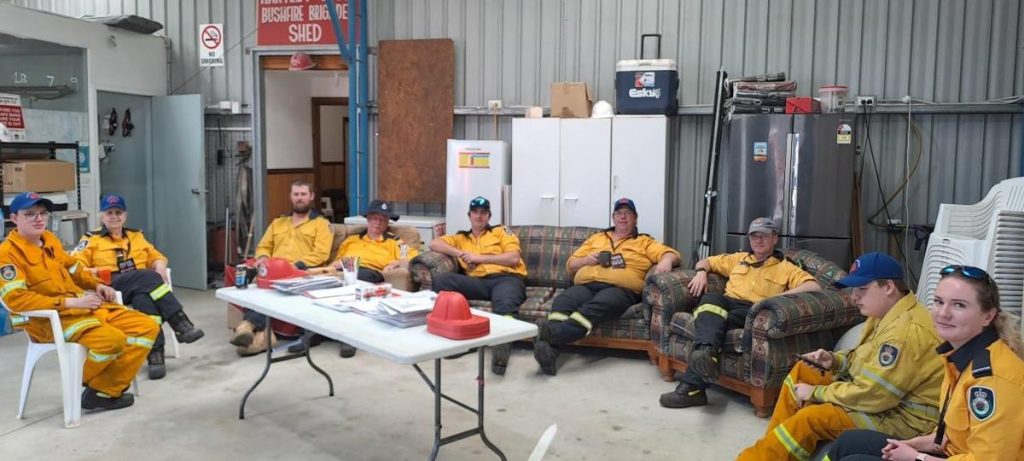
Hartley Rural Fire Brigade Volunteers at Get Ready Day, talking about their experiences
That fire season drew attention to the reality of living with fire in Hartley. They point to a well-thumbed map pinned to the shed wall showing the fire rating of Hartley. Red indicates bush fire prone land that can support or sustain a bush fire.

Red indicates areas within Hartley’s area of responsibility considered bushfire prone or able to sustain a bushfire.
Volunteers flick through phones showing me images of the fire front at Hartley Vale in the early hours of the morning. Instead of the fire cooling, as is common at this time of day, it is spiralling and feeding on itself. The tree canopy is crimson, shooting a golden rain of embers in all directions.

Black Summer fires in Hartley. Image supplied by Corey Gurney.
I am surprised as I hear the calm, assured voices in the footage, and I ask how they prepare themselves for such a dangerous task. Kaitlyn McLaughlin, a young brigade member, explains that she feels well trained and protected on the job. The truck windows are fitted with flame covers, and there are thick fire blankets quickly accessible. The exterior has a ‘halo’ to spray the truck with water, protecting it, and its occupants.
She and Logan Gurney offer a demonstration of the safety equipment. As we sit in the cab surrounded by crackling radios and an array of levers and dials necessary to monitor conditions and the truck, I take the opportunity to ask Kaitlyn how she came to be a member of the brigade and what she has experienced as a volunteer.
Join me for a sample of the activities at Get Ready Day in Hartley as Kaitlyn shares her story:
Each of the volunteers has a similar story. They are here for their community. They tell me that is what Get Ready Weekend is about: helping the community prepare for fire season. I ask if there is anything locals should pay particular attention to?
They indicate there are simple things that apply everywhere but are especially relevant in rural areas like Hartley.
How to Get Ready:
- Maintain your yard and access. Ensure there is a buffer on the boundary of the property with short well-kept grass and that the property is accessible. Clear all debris and material that can burn and prevent access from around a property. A fire truck requires a clearance of 3.5 metres high by 3 metres wide. In the last few seasons of plentiful rain, trees and shrubs may have grown or thickened. If a tree branch is lower than 3.5 metres it can strike the Halo equipment that protects the crew in the truck, endangering lives. In a fire situation there is not enough time to clear vegetation. Access routes for trucks should not be locked.
- Have a mobile water source. A 1000L tank on a trailer with a firefighting pump is invaluable. Depending on use, the pump and water will last up to eight hours, buying valuable time for you and your property. You should have a hose or hoses that reach all around the house.
- If you have a dam, tank or pool on site make sure the RFS knows by placing a ‘SWS’ sign on the entrance to your property. Hartley RFS does not have mains water and is reliant on tank water at the shed, stands in Lithgow or Mt Victoria or static water supplies (dams, tanks, pools) on properties. You can pick up a Static Water Supply (SWS) sign at Hartley Fire Shed.
- If you have a water tank, ensure it has Storz fittings. Storz fittings ensure fire hoses can be connected directly to a water source.
- Notify the RFS and your neighbours of all fires over 1 square metre all year. Given the hilly terrain of Hartley, small yard burn offs or bonfires are easily noticed and frequently reported to the RFS by concerned neighbours and travellers. If the RFS are aware of the fire, it avoids unnecessary callouts.

Handy fridge magnet to remind our household to notify of burns greater than 1 m2 ALL year round.
With the last few seasons of heavy rain, followed by the disruptions of COVID and road closures, I ask if there is a heightened level of risk this year, or if the level of destruction rendered by the Black Summer fires has reduced risk. Corey Gurney indicates they are expecting another busy season.
“Everything that burnt in 19/20 could burn again. There is a lot of paddock grass, and it is drying out fast.” – Corey Gurney
Christina Forester explains that it is important to think about your bushfire plan every year and ensure both you and your property are prepared. The RFS website has tools to assist property owners to assess their risk and prepare. They also offer a one-off free AIDER service to assist infirm, disabled and elderly residents to prepare. If you do not have access to the internet, the RFS can be reached by telephone on 1800 679 737. This phone number is also linked to the National Relay Service for people with hearing or speech difficulty.
As I flick through the resources and consider my next question, a voice booms from the shed radio and it’s all go. There has been a truck breakdown on Mt Victoria Pass, and the brigade is needed. They grab helmets and coats, and one truck disappears, sirens blaring. The Gurney cadets roll up the hoses on the second truck as their father supervises. The driver has the engine running already, another brigade member seated inside. Corey checks all is in order, climbs aboard, and the second truck disappears. It took less than two minutes.
This brigade is not getting ready, they ARE ready.
Are you?

The thanks of a grateful community are greatly appreciated by the Brigade
Take Action:
- Prepare a Bush fire survival plan. The RFS guide can be downloaded at https://www.rfs.nsw.gov.au/plan-and-prepare/bush-fire-survival-plan
- Prepare your property. https://www.rfs.nsw.gov.au/plan-and-prepare/prepare-your-property
- Get to know your Brigade and consider volunteering. https://www.rfs.nsw.gov.au/volunteer/join-the-nsw-rfs. Hartley RFS meet every Thursday in Summer at Hartley Rural Fire Shed, Mid Hartley Road, Hartley. Or contact the brigade at community.hartleyrfs@gmail.com
Share this article:
This story has been produced as part of a Bioregional Collaboration for Planetary Health and is supported by the Disaster Risk Reduction Fund (DRRF). The DRRF is jointly funded by the Australian and New South Wales governments.
